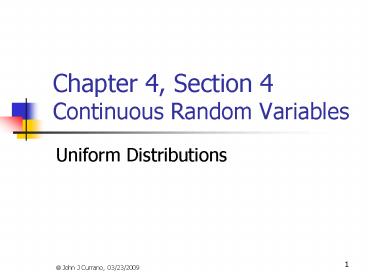Chapter 4, Section 4 Continuous Random Variables - PowerPoint PPT Presentation
1 / 8
Title:
Chapter 4, Section 4 Continuous Random Variables
Description:
... finite set, S, and is as likely to assume any one value in S as any other value. ... likelihood (probability) that it assumes any particular value is zero, so all ... – PowerPoint PPT presentation
Number of Views:30
Avg rating:3.0/5.0
Title: Chapter 4, Section 4 Continuous Random Variables
1
Chapter 4, Section 4Continuous Random Variables
- Uniform Distributions
? John J Currano, 03/23/2009
2
The Continuous Uniform Distribution. A discrete
uniform random variable, Y, models the situation
where Y can take on each of the values in a
finite set, S, and is as likely to assume any one
value in S as any other value. If instead of the
set S being finite, it is a finite interval, ?1,
?2 , and we want to describe an analogous
situation, we cannot say Y is as likely to assume
any one value in S as any other value since, for
any continuous random variable, the likelihood
(probability) that it assumes any particular
value is zero, so all continuous random variables
would have this property. What we might instead
say is that it is as likely for Y to be in any
one part of the interval as in any other part,
but this isnt precise. What does part mean,
and how do we compare different parts? Should it
be as likely for Y to be in the first quarter of
the interval as it is for it to be in the last
half, for example?
3
A random variable,Y, whose support is an
interval ?1, ?2 has a continuous uniform
distribution if the probability that Y is in a
subinterval of ?1, ?2 is proportional to the
length of the subinterval P (a ? Y ? b ) k (b
a ), if ?1 a b ?2 . Such a random
variable has the property that it is as likely to
assume a value in one subinterval of ?1, ?2
as it is to assume a value in any other
subinterval of the same size an equally
likely property.
A continuous random variable, Y, whose density
function, f (y), is constant (k) on the interval
?1, ?2 and zero outside ?1, ?2 has this
property, and it can be shown that these are the
only ones that do. In order for
4
Definition. Y has the continuous uniform
probability distribution on the interval ?1, ?2
(or with parameters ?1 and ?2 ) if it has
density function
We shall write Y Uniform (?1, ?2 ).
5
Y Uniform (?1, ?2 )
Theorem. If Y Uniform (?1, ?2 ), then
f (y) is symmetric about the vertical line
through the midpoint of the interval.
6
Y Unif (0.05, 0.05 )
Example (page 177, 4.54) Let Y be the error in
measuring times using the triangulation method to
determine the range of an acoustic source. It
has been shown that Y can be modeled as
possessing a uniform distribution from 0.05 to
0.05 ?s (microseconds). Then ?1, ?2
0.05, 0.05, so
7
Y Unif (0.05, 0.05 )
a) What is the probability that a particular
measurement will be accurate to within 0.01 ?s?
or, since Y is continuous uniform on the interval
0.05, 0.05,
8
Y Unif (0.05, 0.05 )
b) Find the mean and variance of the measurement
errors.































